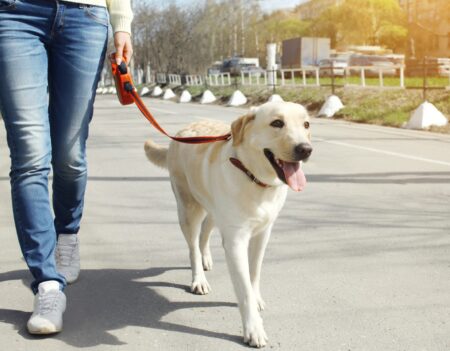
Dog Walking Tips for Less Than Perfect Weather Conditions
From rain and snow to hot summer days, taking your dog for a walk doesn’t always happen in perfect weather conditions. But, don’t let that stop you from enjoying some quality time with your furry friend! for with a little preparation, you can ensure that both you and your pup stay safe and comfortable, no matter the weather. Even if you’re dealing with a blizzard or a scorching heatwave, we’ll provide you with some useful tips to keep you and your dog happy and healthy so, let’s dive into the world of dog walking in less-than-perfect weather!
SEE ALSO: Reasons Why Dogs Are Cleaner than Human
Dog Walking Tips for Less Than Perfect Weather Conditions
Here are five tips for dog walking in less-than-perfect weather:
- Make sure both you and your dog are dressed appropriately for the weather
- Be aware of your physical limits and those of your dog
- Take note of any potential hazards
- Always bring water for you and your dog
- Check your dog’s paws
- Use protective gear for your dog
1. Make sure both you and your dog are dressed appropriately for the weather
It’s important to dress appropriately for the weather when walking your dog, especially during extreme weather conditions. Wearing the right clothing can help keep you and your dog comfortable and safe, and help prevent injuries or illness.
In cold, wet weather, make sure to dress in warm, waterproof clothing, such as a hat, gloves, and boots. Consider wearing layers to help trap heat and keep you warm. For your dog, consider using a waterproof coat or jacket to keep them dry and warm.
In hot, humid weather, dress in light, breathable clothing to help regulate body temperature. Consider wearing a hat and sunglasses to protect yourself from the sun. For your dog, consider using a cooling vest or bandana to help keep them cool.
Aside from clothing, consider using other protective gear like an umbrella in the rain or sunscreen in the sun, to help keep you and your dog safe and comfortable during your walk.
By dressing appropriately for the weather, you can help ensure that both you and your dog stay comfortable and safe during your walk, no matter the weather conditions.
2. Be aware of your physical limits and those of your dog
When walking your dog in less-than-perfect weather conditions, it’s important to be aware of your physical limits and those of your dog. Extreme weather can be taxing on both you and your pet, and it’s important to take steps to ensure that neither of you becomes overexerted or dehydrated.
In cold, wet weather, it can be challenging to maintain your balance on icy sidewalks or slippery surfaces, and prolonged exposure to cold temperatures can increase your risk of hypothermia or frostbite.
In hot, humid weather, excessive sweating and dehydration can be dangerous, as can heat exhaustion or heat stroke.
To protect yourself and your dog, pay attention to signs of overexertion or dehydration, such as dizziness, fatigue, or excessive panting, and adjust your pace or take breaks as needed.
3. Take note of any potential hazards
Being aware of potential hazards is an important part of walking your dog in less-than-perfect weather conditions. Hazards can include:
- Slippery surfaces: Wet, icy, or snowy surfaces can be slippery and increase the risk of falls for both you and your dog. Keep an eye out for slippery areas and adjust your gait accordingly.
- Low visibility: Fog, rain, snow, or low light can reduce visibility, making it harder to see hazards like potholes, debris, or other obstacles.
- Wind and flying debris: High winds can cause flying debris, such as branches or trash, that can injure you or your dog. Be mindful of the direction of the wind and keep yourself and your dog away from potentially dangerous objects.
- Extreme temperatures: Both extremely hot and cold temperatures can be hazardous to your health and your dog’s health. Take steps to protect yourself and your dog from extreme heat or cold by limiting your exposure to these conditions.
4. Always bring water for you and your dog
Staying hydrated is crucial for both you and your dog during a walk, especially in extreme weather conditions because dehydration can cause a range of symptoms like dizziness and fatigue to more serious health problems like heat exhaustion or heat stroke.
In hot or humid weather, it’s important to stay hydrated to avoid overheating and dehydration by drinking plenty of water as it can help regulate body temperature, maintain proper blood circulation, and flush out toxins from the body.
For your dog, it’s also important to bring along enough water to keep them hydrated throughout your walk.
5. Check your dog’s paws
Checking your dog’s paws while walking in less-than-perfect weather conditions is important to ensure that they haven’t suffered any injuries or irritation. Different weather conditions can cause different problems for your dog’s paws, including:
- Cold, wet weather: Icy sidewalks or snowy surfaces can cause frostbite and ice build-up between the paw pads. Check your dog’s paws for any signs of redness, swelling, or ice build-up after a walk in cold, wet weather.
- Hot, dry weather: Hot pavements can cause burns and blisters on your dog’s paws.
- Snow and ice: Snow and ice can cause irritation and injury to your dog’s paws. Ice can get stuck between their paw pads, and snow can build up between their toes, causing discomfort.
- Rain: Wet, muddy conditions can cause bacterial infections or allergies if left unchecked.
After a walk in less-than-perfect weather conditions, check your dog’s paws for any signs of redness, irritation, or injury. Wipe off any dirt or debris, and use a paw balm or moisturizer to protect their paws from drying out or cracking.
6. Use protective gear for your dog
Protective gear can be a helpful tool to keep your dog safe and comfortable during walks in less-than-perfect weather conditions. Here are some types of protective gear that can help and you can buy some of them at Petsmart stores around you:
- Boots or booties: Dog boots can help protect your dog’s paws from extreme cold, hot pavements, and rough terrain. They can also prevent snow and ice build-up between the paw pads and keep your dog’s feet dry in wet weather.
- Reflective gear: In low light or foggy conditions, reflective gear can help make you and your dog more visible to cars and other pedestrians. This can include reflective vests, collars, or leashes, which will reflect light and make you more visible.
- Raincoat or jacket: A raincoat or jacket can help keep your dog dry and warm in wet or cold weather. Look for a waterproof coat that fits your dog well and allows for freedom of movement.
How Cold is Too Cold for Dog Paws?
Dogs have varying tolerances to cold temperatures, depending on their breed, size, and fur coat. However, as a general rule, the following temperatures are considered too cold for most dogs to safely walk on:
- Below 32°F (0°C) or when there is snow or ice on the ground, most dogs should wear protective boots to prevent frostbite.
- Between 32°F (0°C) and 40°F (4.4°C), small breeds, senior dogs, or those with thin fur coats should wear boots or a jacket.
- When the temperature is below 20°F (-6.7°C), dogs should be kept indoors or only allowed outside for short periods, even with protective gear.
It’s important to remember that even if the ground feels okay to you, it can still be too cold for your dog’s paws. If you’re unsure about the temperature or weather conditions, err on the side of caution and keep your dog indoors or walk on shorter routes.
What Temperature Should You Not Walk Your Dog in Winter?
In general, it’s best to avoid walking your dog in temperatures below 32°F (0°C) or when there is snow or ice on the ground. At these temperatures, the risk of frostbite, hypothermia, and other cold-related injuries increases significantly.
Can I Walk My Dog in 27 Degrees Celsius?
27°C (80.6°F) is generally a safe temperature for walking your dog. While it’s on the warm side, it’s not considered dangerous for most dogs, especially if they have a short coat and are in good health.
However, if your dog is a breed that is particularly susceptible to heat, such as a pug or a bulldog, you may want to take some precautions. Walk during the cooler parts of the day, such as early in the morning or late in the evening, and bring along plenty of water for both you and your dog.
Safe Temperature to Walk Dog in Summer?
When walking your dog in the summer, it’s important to be mindful of high temperatures, as they can be dangerous for your pet. Here are some general guidelines for safe temperatures to walk your dog:
- Below 80°F (26.7°C) is generally safe for most dogs to walk.
- Between 80°F (26.7°C) and 85°F (29.4°C) is still safe for many dogs to walk, but be mindful of the humidity and your dog’s breed.
What Temperature is Too Hot to Walk Dogs?
In general, temperatures above 85°F (29.4°C) are considered too hot for most dogs to safely walk, especially for long periods. However, this can vary depending on the breed of your dog, its age, and its overall health.
Some breeds, like pugs, bulldogs, and boxers, are particularly sensitive to heat and should be avoided from being walked during hot weather.
SEE ALSO: Real Reasons Why Dogs Are Hunters
FAQs
Q. What to do when too cold to walk a dog?
When it’s too cold to walk your dog, it’s best to limit their outdoor time and provide them with indoor exercise. Playing fetch or hide-and-seek can provide your dog with mental and physical stimulation without exposing them to the cold.
Q. What is the best weather to walk a dog?
The best weather to walk a dog is usually moderate temperatures between 50°F (10°C) and 70°F (21°C) with little to no humidity.
Q. What is the lowest temperature you can walk a dog?
The lowest temperature you can walk a dog safely is around freezing or 32°F (0°C). However, if your dog has a thick coat or is an arctic breed, they may tolerate colder temperatures.
Q. Can dogs walk in snow without shoes?
Yes, dogs can walk in snow without shoes for short periods, but booties are recommended for longer walks or if the snow is icy or salted.


